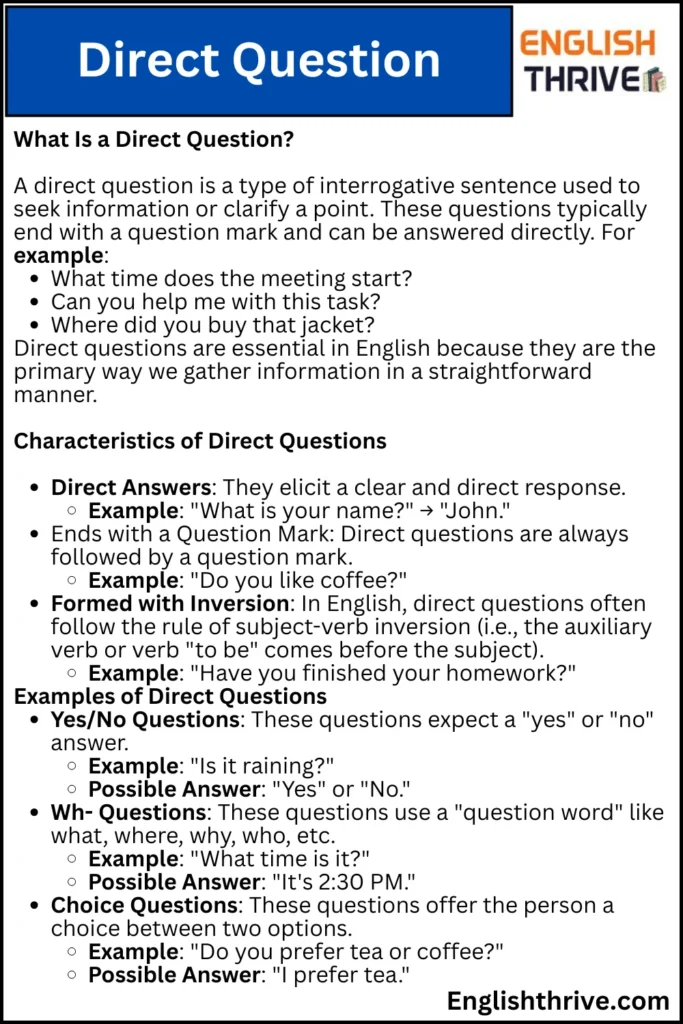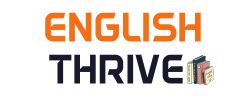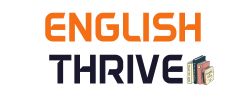In any language, the ability to ask questions is one of the most essential skills for communication. Questions help us gain information, clarify doubts, and encourage further conversation. In English, one of the fundamental types of questions is the direct question. This type of question can be answered directly and typically ends with a question mark. In this article, we will break down what direct questions are, how to form them correctly, and why they are an essential part of both written and spoken English.
Contents
ToggleWhat Is a Direct Question?
A direct question is a type of interrogative sentence used to seek information or clarify a point. These questions typically end with a question mark and can be answered directly. For example:
What time does the meeting start?
Can you help me with this task?
Where did you buy that jacket?
Direct questions are essential in English because they are the primary way we gather information in a straightforward manner.
Characteristics of Direct Questions
Direct Answers: They elicit a clear and direct response.
Example: “What is your name?” → “John.”
Ends with a Question Mark: Direct questions are always followed by a question mark.
Example: “Do you like coffee?”
Formed with Inversion: In English, direct questions often follow the rule of subject-verb inversion (i.e., the auxiliary verb or verb “to be” comes before the subject).
Example: “Have you finished your homework?”
Examples of Direct Questions
Yes/No Questions: These questions expect a “yes” or “no” answer.
Example: “Is it raining?”
Possible Answer: “Yes” or “No.”
Wh- Questions: These questions use a “question word” like what, where, why, who, etc.
Example: “What time is it?”
Possible Answer: “It’s 2:30 PM.”
Choice Questions: These questions offer the person a choice between two options.
Example: “Do you prefer tea or coffee?”
Possible Answer: “I prefer tea.”

Difference Between Direct and Indirect Questions
While direct questions are straightforward and elicit immediate responses, indirect questions are embedded within statements or other questions. In other words, indirect questions don’t always end with a question mark. Here’s a comparison:
Direct Question: “What is your favorite color?”
Indirect Question: “Can you tell me what your favorite color is?”
As you can see, the indirect question is part of a larger sentence and doesn’t end with a question mark. The structure of indirect questions often mirrors that of statements, unlike direct questions that use inversion.
Three Main Types of Direct Questions
There are three primary categories of direct questions based on the type of response they seek: yes/no questions, Wh- questions, and choice questions.
1. Yes/No Questions
These questions are the simplest and require a direct “yes” or “no” response. Yes/no questions usually begin with an auxiliary verb (like “is,” “are,” “do,” “does,” “can,” or “will”).
Example: “Do you like reading books?”
Answer: “Yes, I do” or “No, I don’t.”
Yes/No questions often start with the auxiliary verb or a form of the verb “to be” in the present or past tense:
Example: “Are you ready for the presentation?”
Answer: “Yes, I am.”
2. Wh- Questions
Wh- questions are used when the information being asked for cannot be answered with a simple “yes” or “no.” They begin with question words like what, where, when, why, who, and how.
Example: “Where do you live?”
Answer: “I live in New York.”
Example: “Why did you choose that option?”
Answer: “Because it was the most affordable.”
3. Choice Questions
Choice questions present the listener with two or more alternatives. These questions generally use “or” to separate the options.
Example: “Would you like coffee or tea?”
Answer: “I’ll have coffee.”
Example: “Did you go by car or bus?”
Answer: “I went by car.”
Forming Yes/No Questions
Yes/no questions are typically formed by placing an auxiliary verb or the verb “to be” before the subject of the sentence. The structure is
Auxiliary Verb + Subject + Main Verb + Remainder
Here are some examples:
| Auxiliary Verb | Subject | Main Verb | Remainder | Possible Answer |
|---|---|---|---|---|
| Can | you | swim? | No, I can’t. | |
| Did | she | finish | the work? | Yes, she did. |
| Will | they | arrive | soon? | Yes, they will. |
| Are | you | happy? | Yes, I am. |
Forming Wh- Questions
Wh- questions use question words like “where,” “why,” “when,” “how,” etc., followed by an auxiliary verb, subject, main verb, and the rest of the sentence.
Question Word + Auxiliary Verb + Subject + Main Verb + Remainder
Here’s the structure for Wh- questions:
| Question Word | Auxiliary Verb | Subject | Main Verb | Remainder | Possible Answer |
|---|---|---|---|---|---|
| What | is | your | favorite | color? | Blue. |
| Where | did | she | go? | To the store. | |
| Why | are | you | upset? | Because of work. | |
| How | does | it | work? | It works fine. |
Forming Choice Questions
Choice questions offer two or more options for the respondent. The structure of choice questions is:
Auxiliary Verb + Subject + Main Verb + Option 1 + or + Option 2
Examples:
| Auxiliary Verb | Subject | Main Verb | Option 1 | or | Option 2 | Possible Answer |
|---|---|---|---|---|---|---|
| Do | you | prefer | tea | or | coffee | Tea. |
| Did | they | enjoy | the movie | or | the book | The movie. |
| Is | she | coming | today | or | tomorrow | Tomorrow. |
Common Mistakes with Direct Questions
Even native speakers sometimes make mistakes when forming direct questions. Being aware of these common pitfalls will help you avoid them and ensure that your questions are always clear and grammatically correct.
1. Using a Question Mark in Non-Questions
One of the most common errors is placing a question mark at the end of a sentence that isn’t a question. This often happens with indirect questions, which do not require a question mark. Here’s an example of the mistake:
Incorrect: She asked when the meeting starts.
Correct: She asked when the meeting starts.
In this case, the sentence is an indirect question because it’s embedded within another statement. The question mark should only appear in direct questions.
2. Incorrect Word Order in Yes/No Questions
For yes/no questions, English follows a strict subject-verb inversion rule. The auxiliary verb (or “to be” verb) should come before the subject, followed by the main verb. Forgetting to invert the subject and auxiliary verb is a common mistake.
Incorrect: You are coming to the party?
Correct: Are you coming to the party?
The correct structure follows the form of auxiliary verb + subject + main verb + remainder.
3. Unnecessary Use of “More” in Comparatives
Sometimes, people mistakenly use the word “more” in a comparative sentence when it’s not needed. For example, saying “more better” instead of simply “better” or “more worse” instead of “worse” is incorrect.
Incorrect: This is better than the other option.
Correct: This is better than the other option.
Make sure that comparative adjectives ending in -er do not need “more” before them. Similarly, words ending in -est don’t require most in front of them.
4. Using the Wrong Auxiliary Verb in Questions
Another common mistake involves using the wrong auxiliary verb in a question. For example, with the verb “to be” in the present or past tense, the word order should be:
Incorrect: Did she go to the market?
Correct: Did she go to the market?
When you use did, does, or have, the main verb must return to its base form without conjugation.
How to Improve Your Direct Question Skills
Now that you are aware of the common mistakes, let’s discuss some strategies for improving your ability to ask direct questions in English. Whether you’re using them in casual conversation or professional writing, these tips will help you sound more confident and clear.
1. Practice with Real-Life Scenarios
One of the best ways to improve your direct question skills is to practice with real-life situations. Imagine you’re at a store, at work, or at school, and think of questions you might need to ask. Write them down and practice forming them correctly. For example:
What time does the train leave?
Where can I find the nearest bus stop?
Is this the right form to fill out?
By using actual scenarios, you can make sure your questions are practical and relevant.
2. Read and Listen for Question Forms
Another great method to sharpen your skills is to read books and articles or watch videos where questions are commonly asked. Pay attention to how different types of questions are formed, especially in formal or academic contexts. Notice the word order, the use of auxiliary verbs, and the punctuation.
3. Get Feedback from Native Speakers
If you’re learning English, one of the most effective ways to improve your question-asking skills is by getting feedback from native speakers. When speaking with them, ask questions and see if they can offer suggestions or corrections. Practicing with others helps you build confidence and improve your speaking abilities.
4. Use Online Tools for Practice
There are many online grammar checkers and tools that can help you refine your use of direct questions. Websites and apps like Grammarly can help ensure that your sentences are well-structured and free of common errors. Additionally, platforms like English grammar forums and language exchange websites offer opportunities to practice with peers and native speakers.
Consolation on direct question
Asking a direct question is one of the most effective ways to communicate clearly and gather the information you need. By using the right structure and phrasing, you can ensure your questions are direct, concise, and easy to understand. Whether you’re engaging in a casual conversation or in a professional setting, knowing how to form direct questions will help you get to the point and avoid confusion. With a little practice, asking direct questions will become a natural part of your communication style, making it easier to connect with others and get the answers you’re looking for. So, embrace the power of the direct question—it’s your tool for effective communication!

